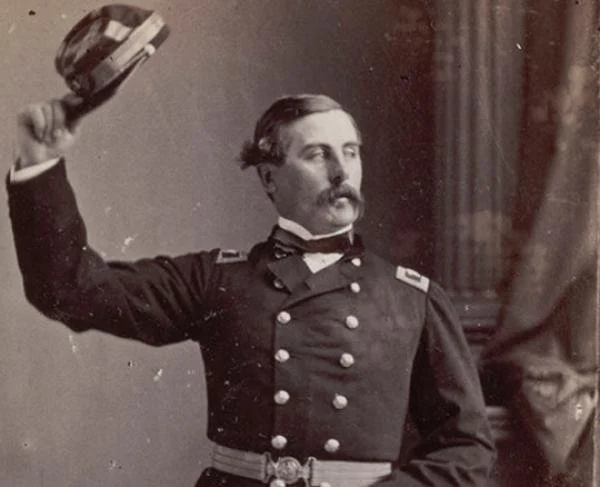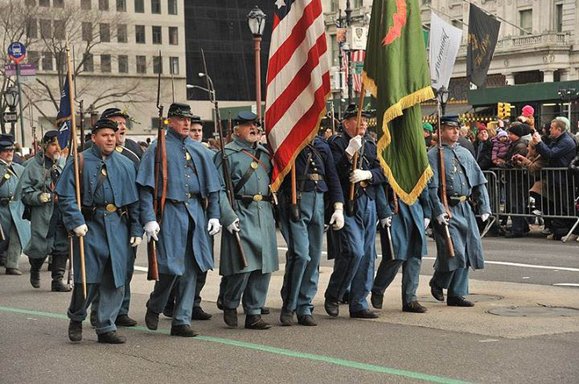July 1, 1862
Malvern Hill, southeast of Richmond VA
“Faugh a Ballagh!” (Clear the Way!) the Irishmen of the 69th Regiment cried as they charged downhill into the teeth of the enemy assault.
The previous days had seen a lot of fighting across the Virginia Peninsula, as the Union Army attempted to reach Richmond and force an early end to the war. Alas, General Lee’s Army of Northern Virginia held their own, pushing them back to the banks of the James River. Malvern Hill - a small rise southeast of the Confederate capital, became their last stronghold during the campaign; should they lose it, the entire army would be at risk of folding entirely.
Throughout the day, the Union had held their own against numerous Confederate attacks. But as the sun started to set over the horizon, the rebels still refused to quit the field and began weakening the Union lines. A pivotal moment was upon them all: should their lines break at any point, it could spell ruin for the Union.
---------------
The 69th NY Regiment was formed as a volunteer militia during the 1850’s in Manhattan by young Irish immigrants who had just arrived in the United States. Some fled the famine, some came in search of opportunity, while others were freedom fighters on the run from the United Kingdom, but they all had one thing in common: their heritage.
When the Civil War kicked off in 1861, the 69th NY Regiment was called upon, and the Irishmen answered: they mustered into service and marched out of New York City for Washington DC to join the Union’s newly formed Army of the Potomac.
Their first action came at the First Battle of Bull Run (Virginia). While the battle was a decisive loss for the Union - one of many in the early years of the Civil War - the 69th was one of the few regiments which held their composure during the fight, even stepping up to cover the rear of the Union army as they retreated in defeat. The 69th did not emerge unscathed, however, suffering over 150 casualties, including their commanding officer - Colonel Michael Corcoran - who was wounded on the field of battle and subsequently captured by the Confederates.
Thus, following Bull Run, command of the 69th fell to Thomas Francis Meagher.
------------
Meagher (pronounced “Mar”) had already become somewhat of a celebrity among the Irish in America, having been a leader of the Young Irelander Rebellion of 1848; an effort to win Ireland’s independence from the United Kingdom. When that effort failed, he was arrested by the British, and found guilty of treason.
General Thomas Francis Meagher during the Civil War.
Before being handed his sentence, he was given the chance to make a statement before the court; an opportunity most typically used to swear allegiance and plead for mercy. However, Meagher went with:
“My Lord, this is our first offense, but not our last. If you will be easy with us this once, we promise on our word as gentlemen to try better next time.”
With that, he was sentenced to exile for life on a remote island in the south Pacific ocean.
But Meagher would escape from exile a couple years later, making his way to New York City to begin anew. Here, he volunteered to join the ranks of the 69th with his fellow Irishmen, eventually rising to the rank of Lt. Colonel and 2nd in command of the regiment before they marched south at the onset of the Civil War.
Colonel Meagher went to work following Bull Run, petitioning the US to reflag his regiment as part of the US Army (rather than the NY state militia) and expand it into a full “Irish Brigade.”
His commanders agreed, and Irishmen from across New York and New England volunteered in droves to join him and the 69th. In total, their ranks increased to over 3,000. Once mustered, the US Army promoted Meagher to Brigadier General, making his command of the Irish Brigade official.
The Irish Brigade also adopted their new unit colors: A green banner with gold trim, featuring a golden harp above which sat a white cloud shooting golden lightning. In Old Gaelic, the words “Who Never Retreated from the Clash of Spears” was printed across the bottom. The flag was designed by Meagher himself, and sewn with green silk by Irish-American ladies in New York. Fun fact: the current flag of the Republic of Ireland (who achieved their independence in 1921, long after he passed) was also designed by Meagher.
Original 69th Regimental Colors, 1861.
Currently on display with the NY State Military Museum.
One other notable aspect that separated the Irish Brigade from the rest of the Union Army was their choice of weapon: Meagher insisted from the beginning that the 69th be armed with the Model 1842 Smoothbore Musket; a firearm seen by most as obsolete in 1861, as newer rifled muskets (such as the Springfield M1861 Rifle, the most popular during the Civil War) offered longer range and superior accuracy.
Model 1842 Smoothbore Musket
But Meagher did not see his men fighting from a distance, and preferred the smoothbore because it fired a “buck-and-ball” shot; a charge holding both a .69 caliber musket ball and a few smaller balls, creating a shotgun-like spread at closer ranges with just one pull of the trigger.
This illustrates how the Irish intended to fight: at the forefront, and up close and personal.
--------------
The Irish Brigade rejoined the Army of the Potomac for the Peninsula Campaign in southeastern Virginia, seeing heavy action during the Seven Days Battles during the last days of June 1862.
Thus brought them to the northeastern slope of Malvern Hill on the 1st of July: After days of fighting and falling back, the Union found themselves with their backs to the James River as the Confederate Army of Northern Virginia continued to attack. They dug in their defenses, placing Meagher’s Irish Brigade along their critical left flank; exactly where the rebels would make their push on to take the hill and trap the entirety of the Union Army on July 1st. Their situation appeared desperate indeed.
“When anything absurd, forlorn, or desperate was to be attempted, the Irish Brigade was called upon.”
-George Alfred Townsend
As the sun set that day, after the Union regiments had spent hours holding off Confederate assaults, the lines began to give way as they ran low on ammunition. General Lee’s officers seized the opportunity: At sunset, they deployed one of their most feared units into the fight: the 9th Louisiana Regiment, nicknamed the “Tiger Rifles” or “Louisiana Tigers,” who began their move out of the treeline and up the hill at fast pace.
But while their ammunition was running low and exhaustion was setting in, the Irish refused to quit the line, and instead advanced it down the hillside into the teeth of the incoming rebels. From General Meagher himself:
“Coming in contact with the enemy, the Sixty-ninth poured in an oblique fire upon them with a rapid precision and an incessant vigor which had the effect of almost instantly staggering and silencing for some moments a fire which seemed to be almost overwhelming.”
-General Thomas Francis Meagher, the Fighting 69th
Map of the Battle of Malvern Hill; the Irish Brigade’s position is represented by the blue lines in the upper left, furthest northwest side of the hill. Their final charge into the Confederate advance pushed them all the way to the tree line in the far upper left of the map.
After an hour of fierce fighting, which brought the two forces face-to-face with hand-to-hand combat, the Irish prevailed: the Confederates were forced back into the woodlands, putting an end to the battle and securing the safety of the Army of the Potomac, and likely the northern war effort itself.
From a soldier in the lines to the right and rear of the Irish Brigade who witnessed the fight:
“The Irish Brigade took position well to the left and front, and opened on the enemy with a most gallant charge and ringing cheer and yell, driving them back with loss and in great disorder…For over an hour the Irish Brigade was engaged in supporting our line on the left, in a severe struggle with a superior force of the enemy, when they finally drove them back to the cover of the woods with great loss. In their last charge they came in close and bloody conflict with the enemy and brought off many prisoners.
Whenever the Irish Brigade was called upon, their coming brought renewed courage and confidence to the jaded troops. ‘Here comes the Irish Brigade!’ ‘Don’t you see the green Flags!’ ‘Three cheers for the Irish Brigade!’ was heard on all sides, and the cheers that filled the air followed them into the post of danger and death, where they were sure to turn the tide of battle in favor of the Union and victory. Their renown will live forever in the pages of American history. Song and story will ever recite their sacrifices on the altar of freedom for their adopted country.”
-Lieutenant Daniel George Macnamara, 9th Massachusetts Regiment
Having witnessed this fight first-hand alongside his generals, and having seen their green flags on the fields of battle throughout the previous seven days, General Robert E. Lee is quoted as saying: “there’s that ‘Fighting 69th.’” The nickname stuck, and the regiment still bears it to this very day as a badge of honor.
The Battle of Malvern Hill marks where the Irish Brigade cemented their reputation as one of the best in either Army. In the years that followed, they would become a centerpiece of the Union Army, fighting gallantly for the Sunken Road at Antietam, on Marye’s Heights at Fredericksburg, and in the wheatfield at Gettysburg. They were also at the Siege of Petersburg, and finally the Battle of Appomattox Courthouse where they witnessed the war’s end as General Lee surrendered his army to General Grant.
“Do Your Duty, Boys!” by artist & fellow veteran Colonel Donna Neary, depicting General Meagher rallying the 69th at Fredericksburg.
While most of the Irish Brigade disbanded at the war’s close, the 69th Regiment continued onward, fighting in WWI, WWII, Iraq and Afghanistan. Their headquarters remains in Manhattan and they march every year in the city’s St. Patrick’s Day Parade alongside their Irish Wolfhound mascots and flying their emerald green flag. Although no longer a purely Irish regiment, they continue to honor both their heritage and our great nation with their service and sacrifice.
This year, in honor of their history, we’re releasing a new Irish-inspired lager in their name: rich, toasty and full of biscuit flavor with a clean finish, this beer is designed for celebration.
With that, this Saint Patrick’s Day we raise our glasses and give a toast to the Fighting 69th. Faugh a Ballagh!





















